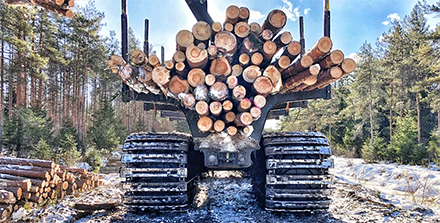With the COP26 climate change summit scheduled in November 2021, political pressure is building to improve sustainability of manufactured products. Consequently, companies are increasingly calling on their suppliers to help them quantify their environmental performance. Source: Engineer Live
A case in point is the specialist forestry equipment made by Swedish manufacturer Olofsfors.
Göran Nyberg, CEO of Olofsfors, says: “We’re currently working on publishing the independently verified carbon footprint of our forestry machine tracks. Our customers will be able to use this data to demonstrate their own environmental impact.”
Tracks provide grip and load distribution to improve forestry machines’ productivity. Because steel is produced using energy-intensive production processes, the tracks have a high embodied carbon dioxide (CO2) content. However, Olofsfors’ engineers keep the carbon footprint down with clever procurement.
Steel from different suppliers can be chemically and physically identical, with the same mechanical properties, alloy content and dimensions. However, sustainability-conscious steel producers have invested in energy efficiency and procure low-carbon energy to melt and roll steel. Basing production on scrap steel also helps as it needs less processing energy than virgin ores. Steel can be remelted and reused to create new steel again and again without compromising its quality.
The other aspect of sustainability is being fit for purpose as tracks with high reliability and long life will reduce operating costs and avoid outages. Therefore, it’s essential to use a steel grade that can withstand the challenging forest environment, where rocks, tree stumps, ice, steep slopes and deep mud are navigated daily.
Olofsfors specified Ovako’s wear-resistant (WR) boron steel. This steel is ideally suited for the forestry environment owing to its high strength and wear resistance. Another important feature of WR steel is its good ductility, which is the measure of how material can be drawn out without becoming brittle.
Olofsfors uses steel bars in special profiles with the right cross-sectional shape and dimensions for its track components. As a result, it can cut bars to length and hot-form them to the right shape before final assembly and welding. This reduces the number of production steps and eliminates the need to invest in a forging machine or other high-cost production equipment.
For companies such as Olofsfors, the key to calculating their environmental footprint is to choose materials and suppliers that provide accurate data. That comes in the form of environmental product declarations (EPDs).
These must be independently verified under the ISO 14025 standard and cover data on energy and CO2 emissions at every step of the sourcing and production processes. Ovako provides EPDs for all of its products and takes account of energy consumption and CO2 emissions from cradle-to-gate.






